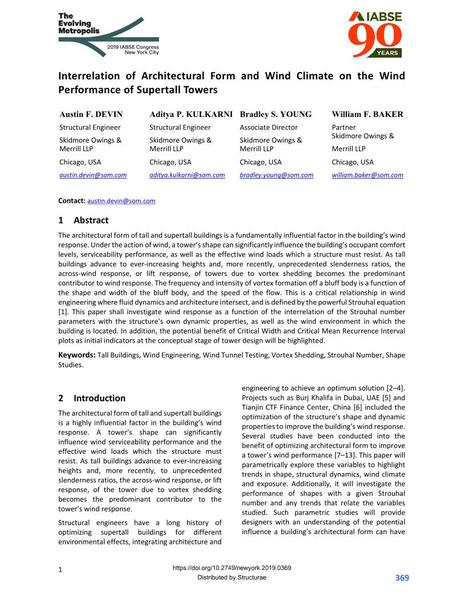Interrelation of Architectural Form and Wind Climate on the Wind Performance of Supertall Towers

|
|
|||||||||||
Détails bibliographiques
| Auteur(s): |
Austin F. Devin
(Skidmore Owings & Merrill LLP)
Aditya P. Kulkarni (Skidmore Owings & Merrill LLP) Bradley S. Young (Skidmore Owings & Merrill LLP) William F. Baker (Skidmore Owings & Merrill LLP) |
||||
|---|---|---|---|---|---|
| Médium: | papier de conférence | ||||
| Langue(s): | anglais | ||||
| Conférence: | IABSE Congress: The Evolving Metropolis, New York, NY, USA, 4-6 September 2019 | ||||
| Publié dans: | The Evolving Metropolis | ||||
|
|||||
| Page(s): | 369-376 | ||||
| Nombre total de pages (du PDF): | 8 | ||||
| DOI: | 10.2749/newyork.2019.0369 | ||||
| Abstrait: |
The architectural form of tall and supertall buildings is a fundamentally influential factor in the building’s wind response. Under the action of wind, a tower’s shape can significantly influence the building’s occupant comfort levels, serviceability performance, as well as the effective wind loads which a structure must resist. As tall buildings advance to ever-increasing heights and, more recently, unprecedented slenderness ratios, the across-wind response, or lift response, of towers due to vortex shedding becomes the predominant contributor to wind response. The frequency and intensity of vortex formation off a bluff body is a function of the shape and width of the bluff body, and the speed of the flow. This is a critical relationship in wind engineering where fluid dynamics and architecture intersect, and is defined by the powerful Strouhal equation [1]. This paper shall investigate wind response as a function of the interrelation of the Strouhal number parameters with the structure’s own dynamic properties, as well as the wind environment in which the building is located. In addition, the potential benefit of Critical Width and Critical Mean Recurrence Interval plots as initial indicators at the conceptual stage of tower design will be highlighted. |
||||
